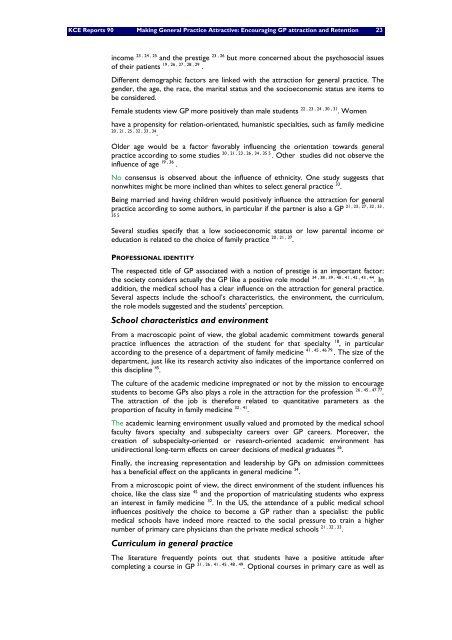Huisartsgeneeskunde: aantrekkingskracht en beroepstrouw ... - Lirias
Huisartsgeneeskunde: aantrekkingskracht en beroepstrouw ... - Lirias
Huisartsgeneeskunde: aantrekkingskracht en beroepstrouw ... - Lirias
Create successful ePaper yourself
Turn your PDF publications into a flip-book with our unique Google optimized e-Paper software.
KCE Reports 90 Making G<strong>en</strong>eral Practice Attractive: Encouraging GP attraction and Ret<strong>en</strong>tion 23<br />
income 23 , 24 , 25 and the prestige 23 , 26 but more concerned about the psychosocial issues<br />
of their pati<strong>en</strong>ts 19 , 26 , 27 , 28 , 29 .<br />
Differ<strong>en</strong>t demographic factors are linked with the attraction for g<strong>en</strong>eral practice. The<br />
g<strong>en</strong>der, the age, the race, the marital status and the socioeconomic status are items to<br />
be considered.<br />
Female stud<strong>en</strong>ts view GP more positively than male stud<strong>en</strong>ts 22 , 23 , 24 , 30 , 31 . Wom<strong>en</strong><br />
have a prop<strong>en</strong>sity for relation-ori<strong>en</strong>tated, humanistic specialties, such as family medicine<br />
20 , 21 , 25 , 32 , 33 , 34<br />
.<br />
Older age would be a factor favorably influ<strong>en</strong>cing the ori<strong>en</strong>tation towards g<strong>en</strong>eral<br />
practice according to some studies 20 , 21 , 23 , 26 , 34 , 35 5 . Other studies did not observe the<br />
influ<strong>en</strong>ce of age 19 , 36 .<br />
No cons<strong>en</strong>sus is observed about the influ<strong>en</strong>ce of ethnicity. One study suggests that<br />
nonwhites might be more inclined than whites to select g<strong>en</strong>eral practice 33 .<br />
Being married and having childr<strong>en</strong> would positively influ<strong>en</strong>ce the attraction for g<strong>en</strong>eral<br />
21 , 23 , 27 , 32 , 33 ,<br />
practice according to some authors, in particular if the partner is also a GP<br />
35 5<br />
Several studies specify that a low socioeconomic status or low par<strong>en</strong>tal income or<br />
education is related to the choice of family practice 20 , 21 , 37 .<br />
PROFESSIONAL IDENTITY<br />
The respected title of GP associated with a notion of prestige is an important factor:<br />
the society considers actually the GP like a positive role model 34 , 38 , 39 , 40 , 41 , 42 , 43 , 44 . In<br />
addition, the medical school has a clear influ<strong>en</strong>ce on the attraction for g<strong>en</strong>eral practice.<br />
Several aspects include the school’s characteristics, the <strong>en</strong>vironm<strong>en</strong>t, the curriculum,<br />
the role models suggested and the stud<strong>en</strong>ts' perception.<br />
School characteristics and <strong>en</strong>vironm<strong>en</strong>t<br />
From a macroscopic point of view, the global academic commitm<strong>en</strong>t towards g<strong>en</strong>eral<br />
practice influ<strong>en</strong>ces the attraction of the stud<strong>en</strong>t for that specialty 18 , in particular<br />
according to the pres<strong>en</strong>ce of a departm<strong>en</strong>t of family medicine 41 , 45 , 46 79 . The size of the<br />
departm<strong>en</strong>t, just like its research activity also indicates of the importance conferred on<br />
this discipline 45 .<br />
The culture of the academic medicine impregnated or not by the mission to <strong>en</strong>courage<br />
stud<strong>en</strong>ts to become GPs also plays a role in the attraction for the profession 26 , 45 , 47 77 .<br />
The attraction of the job is therefore related to quantitative parameters as the<br />
proportion of faculty in family medicine 32 , 41 .<br />
The academic learning <strong>en</strong>vironm<strong>en</strong>t usually valued and promoted by the medical school<br />
faculty favors specialty and subspecialty careers over GP careers. Moreover, the<br />
creation of subspecialty-ori<strong>en</strong>ted or research-ori<strong>en</strong>ted academic <strong>en</strong>vironm<strong>en</strong>t has<br />
unidirectional long-term effects on career decisions of medical graduates 26 .<br />
Finally, the increasing repres<strong>en</strong>tation and leadership by GPs on admission committees<br />
has a b<strong>en</strong>eficial effect on the applicants in g<strong>en</strong>eral medicine 34 .<br />
From a microscopic point of view, the direct <strong>en</strong>vironm<strong>en</strong>t of the stud<strong>en</strong>t influ<strong>en</strong>ces his<br />
choice, like the class size 45 and the proportion of matriculating stud<strong>en</strong>ts who express<br />
an interest in family medicine 32 . In the US, the att<strong>en</strong>dance of a public medical school<br />
influ<strong>en</strong>ces positively the choice to become a GP rather than a specialist: the public<br />
medical schools have indeed more reacted to the social pressure to train a higher<br />
number of primary care physicians than the private medical schools 21 , 32 , 33 .<br />
Curriculum in g<strong>en</strong>eral practice<br />
The literature frequ<strong>en</strong>tly points out that stud<strong>en</strong>ts have a positive attitude after<br />
completing a course in GP 21 , 26 , 41 , 45 , 48 , 49 . Optional courses in primary care as well as

















